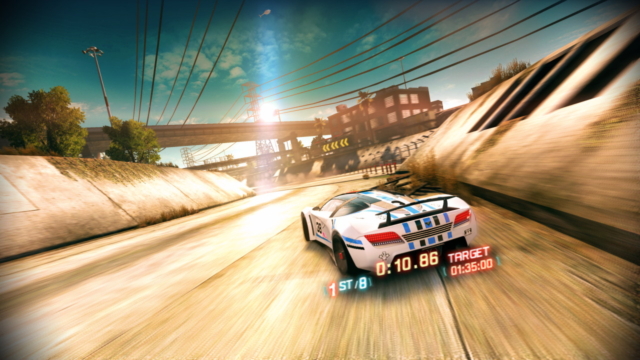
Split/Second: Velocity
Written by: Rik
Date posted: December 8, 2023
- Genre: Racing
- Developed by: Black Rock Studios
- Published by: Disney Interactive
- Year released: 2010
- Our score: 6
In another write-up, earlier this year, we covered the death, temporary or otherwise, of the genuine arcade racer. Rightly or wrongly, your correspondent always considered Split/Second: Velocity (just Split/Second in the US) one half of a double-headed commercial failure that signalled such a fate, with Activision’s Blur being the other. Both were released in 2010 to moderate acclaim and even more moderate sales, leading to the closure of the studios that made them, with the half-decent contemporary reviews and possibility for belated acclaim from cheapskate vultures picking over the bones of their Steam backlogs of little consolation to those involved.
(I’m going to try to avoid constantly harking back to Blur here, even though it is, for my money, a great game, while Split/Second is – spoiler alert – merely a good one. One other major difference between the two was the relative availability and profile of the two games on PC: while Blur was in Steam sales within a few months, one might have been forgiven for thinking the Windows version of Split/Second had been cancelled, with physical copies (at sturdy prices) initially the only available format. It eventually came to Steam in 2014, and – unlike Blur – is still on sale there, at the time of writing).
Anyway, the setup here, as demanded by the circumstances of the era, is that the racing around in circles is on this occasion in service of a highly exciting reality TV show, which is also called Split/Second. The source of the excitement is that racers not only jostle for position on tracks that are rigged with heavy explosives and a whole range of other hazards, but that these traps are triggered by the racers themselves. Rather than having a whole load of weapons at your disposal, the track itself is the weapon! (Or something).
During a standard race, a blue bar beneath your vehicle can be built up, either by drafting behind your opponents, or drifting around corners. At a certain point, the game will direct you towards the activation of so-called Power Plays, which might be a building exploding, a bridge collapsing, or a helicopter dropping a flaming barrel on the road ahead. Time it right, and you’ll delight in passing by the burned out metal shells of your temporarily vanquished opponents en route to the front of the race; get it wrong, and you might be caught up in the carnage yourself.
It’s a pretty compelling mix of novel concept and a refreshingly stripped-down approach: there’s really not too much more to it than that, with the only other real consideration being whether to save up your power until it turns red for a Stage 2 Power Play, which is either a piece of destruction on a slightly larger scale, or on some courses, a case of the entire track ahead being ripped up and a new route forged. While even some of the standard Power Plays can be quite visually spectacular, the bigger boys have the ability to occasionally invoke a sharp intake of breath and/or (depending on your age) a chuckle at how things have changed since the power-ups in an arcade racer meant a speed boost or an oil slick. [Is everything ok at home? – Ed.]
There are no such things here, though. Power Plays are literally the only weapons at your disposal, with vehicle choice being the other available variable to tweak (other than your own expertise on the track, obviously). On which subject, it’s the usual unlockathon of increasingly speedy and sturdy vehicles, with low-slung supercars, bulky muscle cars and big trucks all available to be deployed, according to the needs of the course or event and/or your own personal preferences. (They all have fake names, even if some do look vaguely familiar, and the menu text attempts to whip up excitement in mildly ludicrous fashion, with one mid-range vehicle being described as suitable only for ‘an adrenaline junkie who is clinically insane’).
Further variety is provided by additional events, including Detonator: time trials in a specific vehicle, in which you must dodge Power Plays as triggered by the TV producers rather than other racers; Survival, which involves overtaking trucks and dodging exploding barrels; and Air Strike, during which you must swerve to avoid guided missiles fired by an overhead helicopter while building up your meter to the point at which you will somehow (via a mysterious mechanism not shown on screen) be able to deflect the missiles back from whence they came and destroy your hovering foe.
To be fair, this missile dodging event is the most engaging of the three, and in the best traditions of such things, will have you developing an instinct over repeated plays of just how good you need to be in order to finish at the top of the leaderboard, and flipping between vehicles in service of getting to this level. The truck/barrel events, meanwhile, are the polar opposite, with success often seeming to be down to pure luck on the first few tries, and the time-trials, usually a personal favourite, let you achieve second place with relative and consistent ease, but also leave you around 5 seconds short of the top time and no clue of how to improve matters. Eventually, it seems wisest to simply accept the silver medal and move on.
Which you can, as long as you’ve unlocked the next event, and are ultimately able to progress to the ‘season finale’, known as an Elite Race and characterised as such by opponents having superior cars and names like ‘Big Dog’ and ‘Danger Man’ (in standard races, they’re all referred to by fairly standard surnames, like it’s a posh school: “You were wrecked by Edmonds”; “Miss! Miss! Edmonds wrecked my car, Miss!”)
You only have to finish third or better to unlock the next season, and prompt a gravelly-voiced trailer about what might happen ‘Next time… on Split/Second’ featuring generic chaos while a series of disclaimers whizz along the bottom of the screen at a comically rapid pace (which genuinely did make me laugh, on the assumption that it was a deliberate pastiche rather than the actual disclaimers for the game as required by publishers Disney, which I guess could be possible).
It has to be said that the TV format actually does very little to distinguish between episodes, and instead Split/Second is the usual mishmash of events spread fairly thinly across the game, with a considerable amount of repetition. It’s a shame, because with set pieces like this, you imagine things getting bigger and bigger and building to a crescendo, but it’s not the case. There’s a bit in an early race where a jumbo jet races towards you and explodes, and you think: holy shit, if they’re doing this now, I wonder what other stuff is going to happen later on. Not much else that sticks in the memory, as it turns out.
While undoubtedly a fast and good looking game, there’s a sense that there’s actually not enough beneath the surface, a feeling that persists and builds as you progress. Repetition of tracks and assets is one thing, and not overcomplicating the core game mechanics another, but after a certain point, ‘press this button to make things go boom’ starts to wear a little thin. There’s not an awful lot of method to it, and with the lack of defensive weapons available, taking the lead does seem like you’re a sitting duck waiting for the inevitable to happen. While some hazards can be endured or avoided, depending on the strength of your vehicle, if someone decides to collapse a building on top of you, there’s not really a lot you can do about it.
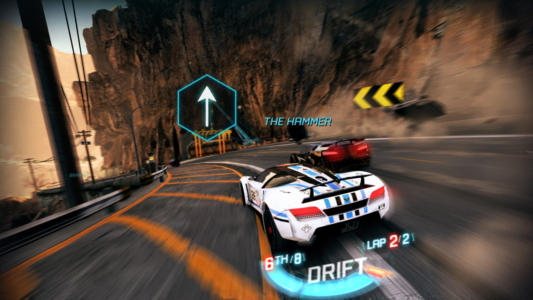
Some Power Plays are shortcuts. We’ll use such cunning tactics to sail ahead of noted and feared Elite rival, ‘The Hammer’ here.
On top of that, a well-calibrated racer should have you desiring perfection and victory, calculating after each race what little things you might do better next time. We already mentioned the element of luck in the barrel-dodging events, and the sense of being powerless to improve during time trials, but simply smashing through some of the standard races without displaying very much skill or mastery is also possible. When you’re considering giving up a race as hopelessly lost on the final lap, only to end up winning, it’s a sign that something probably isn’t quite right. The handling model is pretty arcadey and lightweight, and other than the drift mechanic, skilful deployment of which can help you earn extra power when needed, there’s not a lot to that either.
Successful completion of the career mode features a coda which hints at a sequel, but the finale of the last season is otherwise nothing special. At this point, my thoughts turned briefly to the much-maligned Need for Speed: The Run, a story-based game that definitely wouldn’t win any prizes for storytelling, but which did at least ensure, through its narrative structure and approach, that each phase felt different and that events were building towards something. (It even had a very good ‘exploding track’ segment of its own, and although the ending was pretty annoying, it did at least feel like the game had built towards something, and provided the player with some kind of pay-off for the previous 10 hours or so of racing).
Split/Second isn’t alone in this, of course. Even the mighty Blur (sorry) largely failed to inject much excitement into its boss duels, while the final race was also somewhat of a damp squib. However, if Split/Second was really to have committed to its conceit, rather than it appearing to serve as an excuse for blowing a load of stuff up, it could have built momentum through each season and gone out with something spectacular at the very end – just like your favourite TV shows (except that famous one that you didn’t like the ending of).
Instead, what we have is a pretty good looking and intermittently thrilling racer which never seems to get its hooks into you in quite the way it should. In many respects, it’s very well put together, and I did find myself marvelling at how well the chaos was choreographed and controlled without too many glitches presenting themselves.
However, shrugging off second place finishes and blundering through races to win aren’t qualities associated with the very best racers. As with the likes of Burnout: Paradise, all the mayhem is briefly diverting, but soon becomes ubiquitous and starts to lose its thrill. While the teased sequel might well have been the brilliant second series that makes up for an uneven first, unfortunately Split/Second was a show that got cancelled instead.

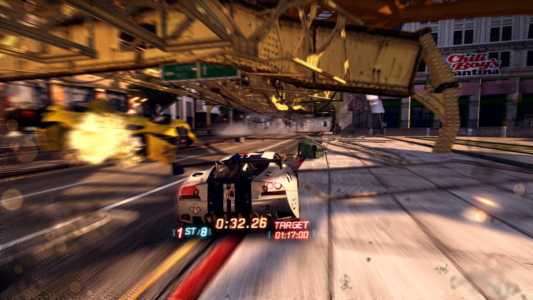
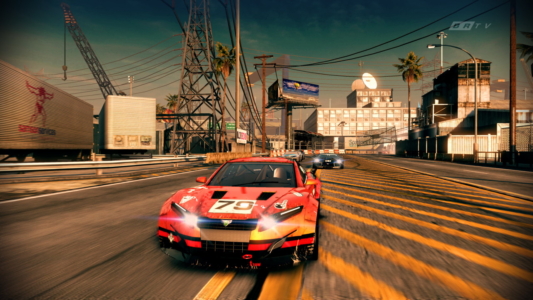
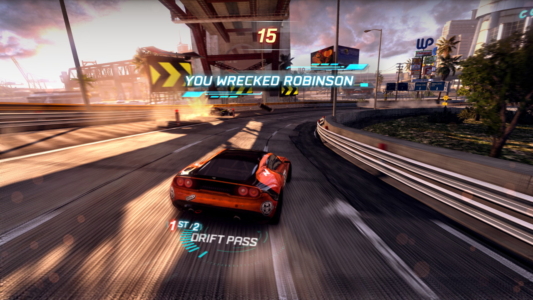
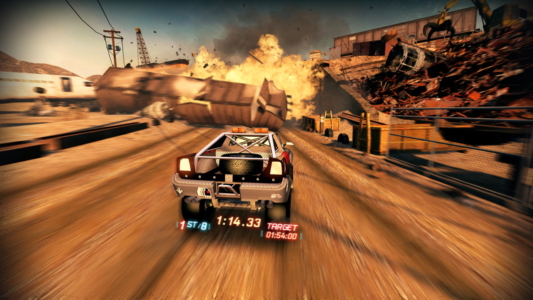

 Posts
Posts